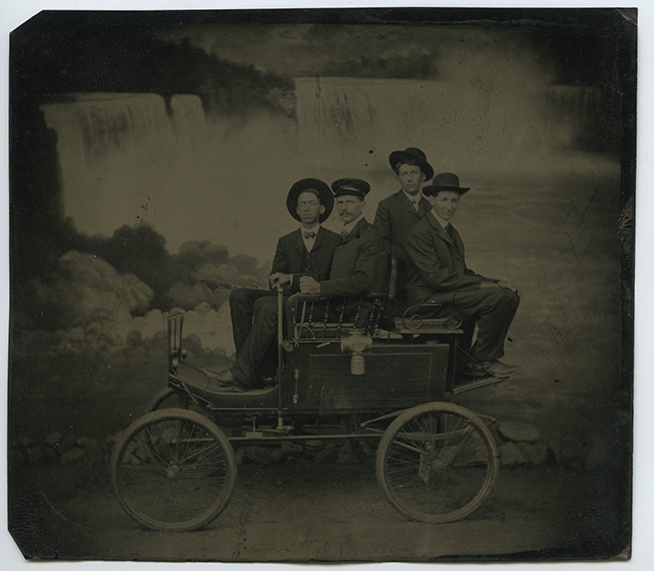Early Tourist Photography at Niagara Falls

By Victoria Abel, M.A.
In 1839, when photography was invented, Ontario as a province did not exist and the New York village of Niagara Falls would not be incorporated for another nine years. Despite these facts, the need for easy transportation and access to Niagara Falls had already been expressed and fulfilled in 1836 with a rail line built between the Erie Canal and Niagara Falls, which irrevocably opened the Falls to the broader public. This timeline shows that photography and Niagara Falls as a tourist site, if not born simultaneously, were incredibly close in their inceptions.
![Unknown. [Unidentified women, Niagara Falls backdrop], 1880-1900. Tintype, 6.4 × 5.1 cm. Richard Bell Family Fonds, Brock University Archives. Courtesy Brock University Archives, Image © 2017 Art Gallery of Ontario. On view in Free Black North at AGO until October 1, 2017. Black and white photo of two women sitting in front of Niagara Falls](/sites/default/files/imce/women-niagara.jpg)
In 1853, Saul Davis built a hotel called Table Rock House where his son also ran a photographer’s studio where visitors to the Falls could have their pictures taken in front of backdrops. The sites from which pictures were taken were quickly defined and claimed by photographers and photo studios, with the Davises claiming Table Rock in Ontario and Platt D. Babbitt claiming Prospect Point in New York.

Babbitt was known for setting up his camera, surreptitiously taking photographs of tourist groups, and then offering the images to the group for sale. He primarily made daguerreotypes, which was a medium that made it very difficult to capture landscapes because the exposure process was fairly slow, but Babbitt was very well known for the quality and beauty of his images. He was so protective of this area of the Falls that if another photographer attempted to come and photograph there, Babbitt and his friends would wave umbrellas between the interloper and the subject in order to ruin the shot. Nonetheless, many photographic studios were established at Niagara Falls and frequently visited by tourists, which is one of the reasons why the Niagara Falls image is so recognizable to Canadians.

The photographic fascination with Niagara Falls continues today, expressed by the average tourist through the handheld camera or the smart phone. Social media has provided new ways for visitors to share their experience at Niagara Falls with friends, family, and beyond. With the first week of August being one of the busiest for tourism and Saturdays being the most popular for posting images to platforms like Instagram, the first Saturday of August has become peak time for social media posts about Niagara Falls.
Further Reading
Bannon, Anthony. The Taking of Niagara: A History of the Falls in Photography. Buffalo: Media Study, 1982.
Revie, Linda L. The Niagara Falls Companion: Explorers, Artists, and Writers at the Falls through the Twentieth Century. Waterloo: Wilfrid Laurier University Press, 2003.
“The Front.” Niagara Falls Info. Accessed May 28, 2017. https://www.niagarafallsinfo.com/niagara-falls-history/niagara-falls-tou....
This blog is part of an ongoing series that reflects on the nature and meaning of family photos. It is related to The Family Camera Network project, a community archive project to collect and preserve family photographs with their stories. #ROMfamcam
